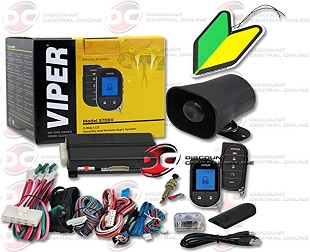
Car alarm systems can fall into two major classifications, a passive warning system or an active one. These would refer to the methods of arming the security devices. Both types can be installed by handy do it your self types. There is web based documentation available that can help you decide what system to get and provide details about the difficulty level of of choice.
The kind of unit installed on your vehicle may also change your total insurance costs. A passive automotive security device will switch on automatically when the ignition key is removed or the doors are locked. Sometimes they can be more effective than active type alarm systems. Active alarm systems are armed manually with a key fob transmitter, keypad, a toggle or pin switch.
Pin switches are similar to the ones used for turning on the courtesy lights when the doors are open and closed and can be used to arm the alarm as well. When a door, hood, or even the trunk lid is opened, the pin switch closes.
This completes the electrical circuit allowing current to flow and the alarm sounds. It may also turn itself off automatically as many security system modules run a timer on average of 2-5 minutes provided the intruder has stopped trying to enter the automobile.
This is a handy feature because it helps in preventing the battery from being drained completely. In most cases these alarm systems will reactivate themselves after a certain time period passes so they are armed and ready to cry out for help again.
On most car alarm systems the drivers door lock is the master switch that controls the arming of the system. If the alarm is activated by mistake or the alarm needs to be turned off this is accomplished by inserting the key into the driver’s side front door cylinder and unlocking it manually with a wrist twist.
Other factory systems will disengage after the recognized security key is installed into the ignition and then the on position is selected. Some of the latest factory installed alarms are utilizing an ultrasonic sensors that looks like a tiny speaker.
The placement of these devices will differ depending on the year, make and model. These noise sensors are used to detect motion and sounds that will trigger the alarm if there is movement inside the vehicle. The alarm will also be engaged, if a sharp noise like a window breaking occurs.
The Auto Alarm Monitoring Systems
One of the most popular types of sensors would be one that is current sensitive. These sensors will monitor the vehicle’s electrical system and look for spikes or increases in usage. This is a likely indication that unauthorized door opening has occurred.
Motion detectors monitor changes in the vehicles incline or angle such as when someone is attempting to steal the tires or tow the vehicle. When movement is detected, the alarm is automatically triggered.
Most modern alarm systems are designed to sound an alarm, turn on the hazard lights, and cause the high beams to flash along with the hazard lamps. Some models will have indicator lamps on the inside of the automobile to alert others that the alarm is set.
This is also handy for reminding the driver to turn the alarm off before entering the car. Some common types of a visible alarm indicator lamps would be a red flashing LED light. To avoid false alarms some modern systems allow for the disabling of individual sensors.
An example of the usefulness of this function would be being able set your system yet disengaged the motion sensor inside the vehicle that may be activated by a pet inside the car.
Most law enforcement officials recommend audible alarms over the silent page type alarms. This simple loud audible alert will call attention to the car and may startle the intruder. A pager type alarm may not be safe because many people will recklessly confront the thief alone rather than call the police. Although increased numbers of vehicles are being factory equipped with car alarm systems and anti-theft devices most installation and repair work is done by General auto mechanics.
Many DIY car alarm installation guides are available to assist the do-it-yourself driveway mechanic. The first and only one I purchased so far is reviewed on my page about car alarm systems.
The home page is a good place to go for a brief rundown of what else is covered on this automobile website. This next link will take you to the auto facts.org homepage.
Give this car alarm system page a bookmark or share with a friends.
